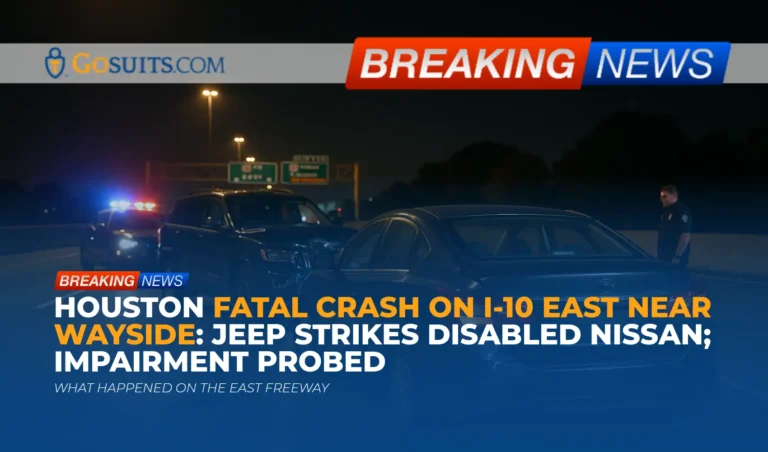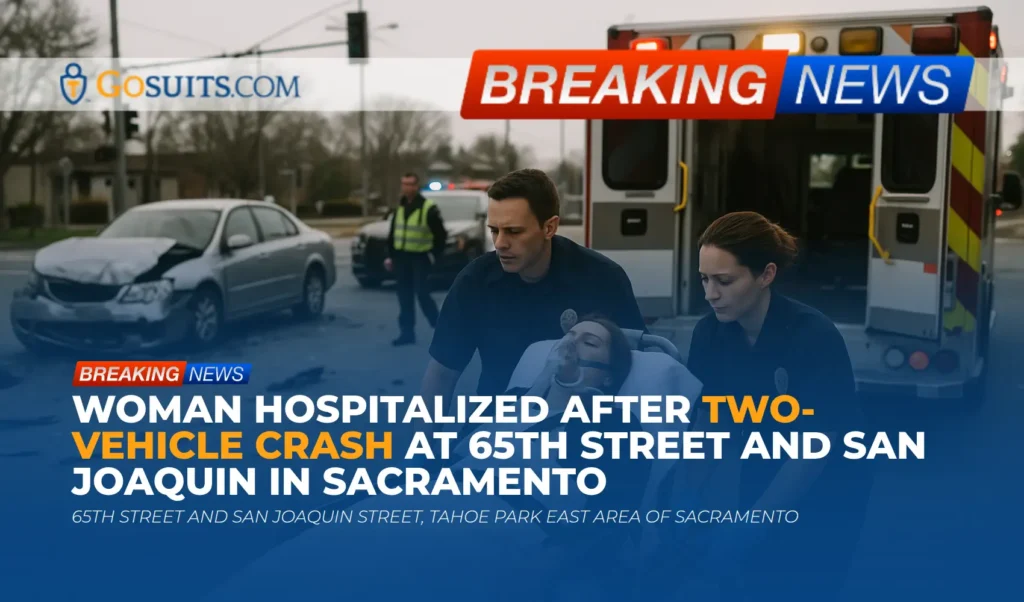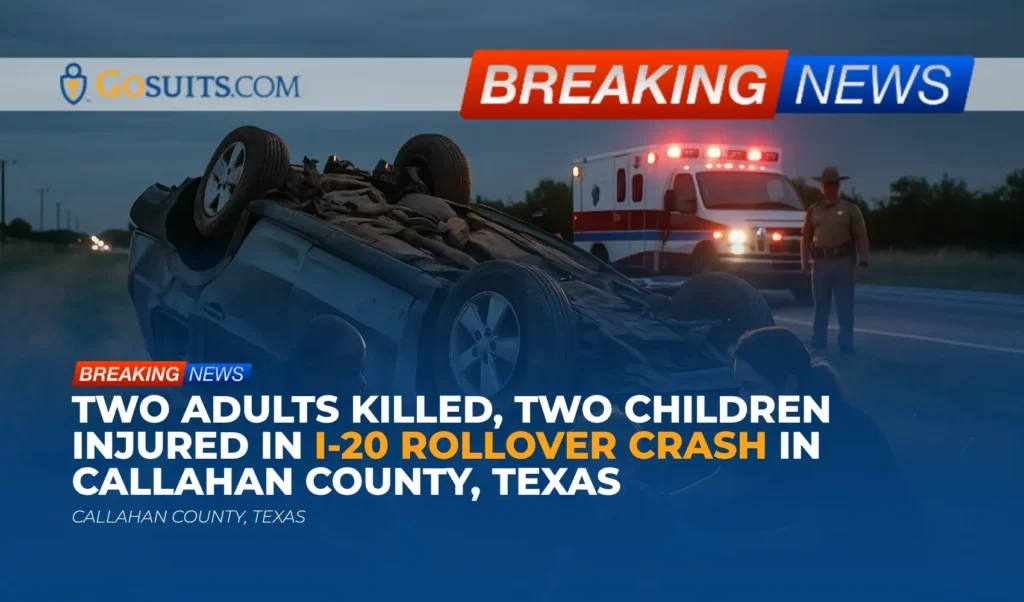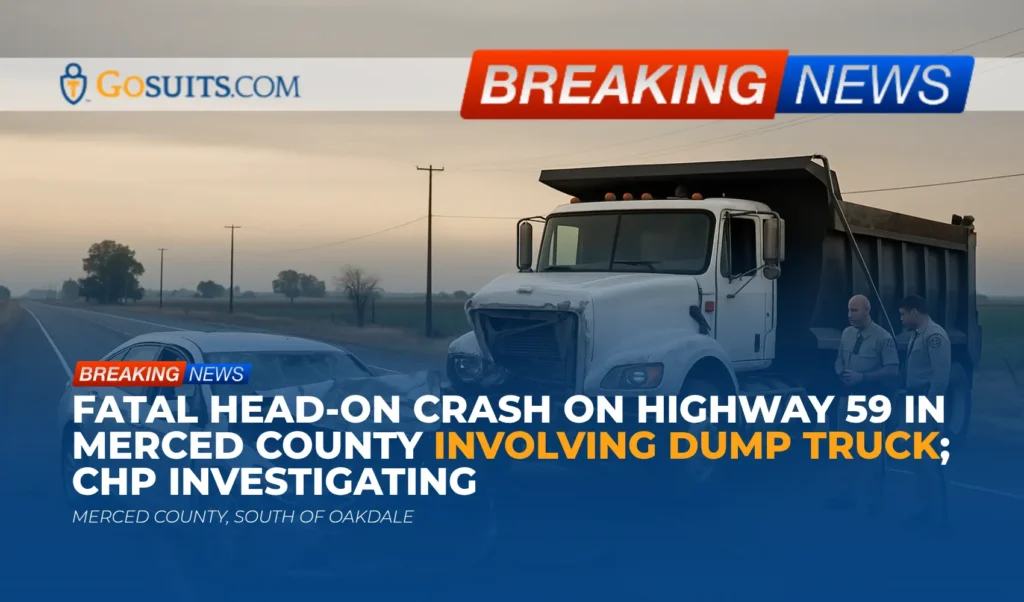- What Happened on the East Freeway
- Where and When the Crash Occurred
- Law Enforcement Statements and Ongoing Inquiries
- Safety and Legal Context Under Texas Law
- How Serious Crashes Are Investigated and What Evidence Matters
- How Families Can Obtain Key Records in Houston and Harris County
- Potential Civil Liability Considerations in Rear-End Collisions Involving Disabled Vehicles
- Insurance and Claims Considerations After a Fatal Highway Crash
- Practical Safety Steps if a Vehicle Stalls on a Freeway
- Supportive Public Resources for Bereaved Families
- Time Limits and Deadlines That Often Apply in Texas
- Commentary from Gosuits Houston, Texas Personal Injury Attorney
- Action Steps to Protect Rights Now
What Happened on the East Freeway
According to statements summarized from local reporting and police information, a fatal crash occurred on the East Freeway in Houston in the early morning hours of Sunday. A blue Nissan reportedly became disabled in the outbound lanes near Wayside. Shortly afterward, a Jeep traveling at a high rate of speed struck the rear of the disabled Nissan. The driver of the Nissan died at the scene. Officers indicated they were evaluating the Jeep’s driver for possible intoxication or impairment. Traffic lanes remained closed for several hours and reopened at approximately 8 a.m.
Our thoughts are with the family and friends impacted by this loss. The details below are intended to help community members understand how crashes like this are assessed, what records may be available, and what general civil law principles may be relevant in Texas after a serious or fatal collision.
Where and When the Crash Occurred
The collision reportedly happened just before 2:30 a.m. on the East Freeway (commonly known as I-10 East), outbound near the Wayside area in Houston. Early-morning hours can present increased risk on high-speed roadways due to reduced visibility, fatigued or impaired drivers, and higher average travel speeds when traffic volumes are low. Federal safety agencies have documented that speeding and impairment remain significant contributors to severe and fatal crashes nationwide, particularly at night. The National Highway Traffic Safety Administration provides data on both speeding and impaired driving as persistent risk factors in fatalities on U.S. roads. See NHTSA’s information on drunk driving and speeding.
Law Enforcement Statements and Ongoing Inquiries
Houston police indicated that they received reports of a Jeep traveling at a high rate of speed and that the Jeep rear-ended a disabled Nissan. HPD also stated the Jeep driver was being checked for intoxication or impairment to determine whether charges may be considered. In fatal crash investigations, officers typically secure the scene, document roadway evidence, interview witnesses, and may request toxicology testing depending on the circumstances. Ultimately, investigative findings can be important in both criminal and civil contexts. While any potential criminal issues are separate from civil claims, the underlying facts discovered by investigators can overlap.
Safety and Legal Context Under Texas Law
Texas rules on speed and safe operation
Texas law requires motorists to control speed and operate safely for conditions. The Texas Transportation Code states that drivers must not drive at a speed greater than is reasonable and prudent under the circumstances then existing, considering actual and potential hazards. See Transportation Code §545.351. Operating at an unsafe speed or failing to control speed can be evidence of negligence in a civil claim when it contributes to a collision.
Stopped or disabled vehicles on the roadway
Texas law generally prohibits stopping, parking, or standing a vehicle on the main traveled part of a highway when it is practicable to move off the roadway. That said, a vehicle may become disabled or otherwise unable to move, and in those cases, drivers should act reasonably to warn others and reduce danger. See Transportation Code §545.301 (stopping, standing, or parking outside a business or residence district). Additionally, hazard lamps are permitted to warn other drivers when a vehicle is stopped or disabled. See Transportation Code §547.331.
From a civil perspective, whether a vehicle could reasonably be moved, whether hazard lights were operable or activated, and whether the driver exited to a safe location are fact questions investigated by authorities and later assessed in the claims process.
Impairment and its role in civil cases
If impairment is suspected, that can be significant in a civil injury or wrongful death claim. Federal safety data consistently shows impairment is linked to a substantial share of traffic fatalities. NHTSA’s impaired driving page provides national figures and prevention strategies: NHTSA Drunk Driving. In a civil case, evidence of impairment can affect how fault and damages are evaluated under Texas law, but each case turns on verified facts and admissible evidence, not speculation.
How Serious Crashes Are Investigated and What Evidence Matters
In fatal highway collisions, police and, at times, specialized crash reconstruction teams collect and analyze evidence such as:
- Scene documentation including lane positions, skid marks, gouge marks, final rest locations, and debris fields.
- Vehicle inspections for crush profiles, airbag deployment, event data recorder downloads, and mechanical condition.
- Visibility and lighting conditions at the time of the crash, including street lighting, weather, and sight distance.
- Speed and following distance indicators derived from vehicle data and physical evidence.
- Witness statements and 911 calls, which can corroborate timing and behavior of vehicles.
- Toxicology screening of involved drivers if impairment is suspected, performed under applicable laws and protocols.
- Surveillance or traffic cameras from nearby businesses or agencies, when available.
Families often want to know what the technical reconstruction will reveal. Some findings arrive quickly, but full reports, particularly those involving toxicology, can take weeks. It is common for official crash reports, supplemental diagrams, and medical examiner findings to be finalized on different timelines.
How Families Can Obtain Key Records in Houston and Harris County
Even as investigations continue, several official records may be available to next of kin or their authorized representatives. Access rules and timing vary:
Houston Police Department crash report
- What it is: A Texas Peace Officer’s Crash Report (often called CR-3), containing basic facts, involved parties, and preliminary contributing factors noted by the officer.
- Where to request: HPD provides information on reports through the City of Houston’s website. See the HPD Records Division page at houstontx.gov/police/records.htm.
- State-level access: Texas crash reports are maintained by the Texas Department of Transportation (TxDOT). TxDOT explains who can obtain crash reports and how to request them on its website: txdot.gov. Look for the crash reports and records section.
Medical examiner and autopsy information
- Harris County Institute of Forensic Sciences: The medical examiner’s office for Harris County manages decedent services, autopsy findings, and next-of-kin notifications. Families can find information on requesting records at ifs.harriscountytx.gov/Divisions/Decedent-Services.
- Death certificates: Certified copies are issued through the Texas Department of State Health Services Vital Statistics. See dshs.texas.gov/vital-statistics.
Supplemental materials that may exist
- Scene photos, diagrams, and body-cam footage collected by police, accessible under applicable public information laws with privacy protections.
- 911 audio and CAD logs, sometimes obtainable through the city’s public records process.
When requesting records, families should have the incident date, approximate time, location, and, if available, the HPD incident number. Processing times vary.
Potential Civil Liability Considerations in Rear-End Collisions Involving Disabled Vehicles
Each collision is unique, and no single factor determines responsibility. In Texas civil cases, several issues are commonly evaluated:
- Speed and control: Whether a driver operated at a reasonable and prudent speed given traffic, lighting, and conditions. See Transportation Code §545.351.
- Lookout and response time: Whether a driver kept a proper lookout and had adequate time and distance to perceive and avoid a stopped hazard.
- Vehicle lighting and warnings: Whether the disabled vehicle’s lights were functioning, hazard lamps were used, and any other reasonable precautions were taken, consistent with §547.331.
- Location of the stopped vehicle: Whether it was practicable to move the disabled vehicle to the shoulder or another safe area under §545.301.
- Impairment: Credible evidence of impairment by alcohol or drugs affecting reaction time, decision-making, and lane control, with national data summarized by NHTSA.
- Comparative responsibility: Texas applies proportionate responsibility in civil cases. Fault can be allocated among parties based on evidence. See Texas Civil Practice and Remedies Code Chapter 33.
- Potential third-party responsibility: Depending on facts, potential claims could include negligent entrustment, employer responsibility if a driver was on the job, or vendor liability if a service provider created an unsafe condition. These are evidence-dependent inquiries.
Because each case turns on specific facts and evidence, families often consult with a seasoned personal injury attorney to understand how these legal standards may apply to their circumstances.
Insurance and Claims Considerations After a Fatal Highway Crash
Navigating insurance is often overwhelming in the wake of a loss. Some general considerations in Texas include:
Liability coverage and claims
- At-fault driver’s liability insurance: In many cases, claims are presented to the at-fault driver’s insurer for wrongful death damages. This process involves establishing fault and documenting losses.
- Comparative responsibility: Insurers may argue that a disabled vehicle contributed to the collision. Texas proportionate responsibility rules in Chapter 33 affect how compensation is evaluated.

Potential first-party benefits
- Uninsured/Underinsured Motorist (UM/UIM): If the at-fault driver has insufficient coverage, UM/UIM on the decedent’s policy may apply, depending on policy terms.
- Personal Injury Protection (PIP) or Medical Payments (MedPay): Texas policies may include PIP or MedPay that can assist with certain expenses, subject to policy limits.
Communicating with insurers
- Contact an attorney first: Before giving recorded statements or signing authorizations for any insurer, it is prudent to speak with an attorney. What is said to an insurer can be used later in ways that affect the claim.
- Preserve evidence: Request that involved insurers preserve vehicle data and other evidence. Written notice can help prevent spoliation.
Understanding insurer obligations
The Texas Department of Insurance publishes consumer guidance on auto claims handling and timelines, which can help explain the process and common pitfalls. See Texas Department of Insurance for consumer resources.
Practical Safety Steps if a Vehicle Stalls on a Freeway
Breakdowns can happen to anyone, and high-speed roads pose acute risk. Public safety agencies offer general recommendations for stranded motorists, including:
- Signal immediately: Turn on hazard lights and, if possible, move to the right shoulder or an exit ramp. Texas permits hazard lamps when a vehicle is stopped or disabled under §547.331.
- Call for help: Dial 911 if the vehicle is disabled in a lane or if you cannot get to a safe location. Provide precise location markers if available.
- Exit to safety: If the vehicle is stopped in a live lane and it is safe to do so, exit the vehicle and move well away from traffic, preferably behind a barrier.
- Stay visible, but stay protected: At night, visibility drops sharply. Reflective triangles or flares can be helpful on low-speed roads, but on freeways, prioritize getting out of travel lanes to a secure place.
- Follow government safety guidance: NHTSA’s pages on risky driving and roadside emergencies provide practical safety points for drivers; see NHTSA Road Safety. FEMA’s Ready.gov also offers preparedness tips for vehicle emergencies: ready.gov/car.
These are general safety guidelines. Conditions vary in the real world, and personal judgment based on the immediate situation is essential.
Supportive Public Resources for Bereaved Families
- Houston Police Department Records Division: Information on obtaining crash reports and related records is available at houstontx.gov/police/records.htm.
- Harris County Institute of Forensic Sciences: Decedent services, autopsy reports, and next-of-kin assistance at ifs.harriscountytx.gov/Divisions/Decedent-Services.
- Texas Department of State Health Services Vital Statistics: Death certificates and vital records at dshs.texas.gov/vital-statistics.
- TxDOT Crash Reports and Records: State-level information and eligibility to request reports at txdot.gov.
- NHTSA Safety Information: National data and safety resources on impaired driving and speeding at nhtsa.gov.
- Texas Attorney General Crime Victims’ Compensation: In limited circumstances involving criminal conduct, families may review eligibility information at texasattorneygeneral.gov/crime-victims/crime-victims-compensation.
Time Limits and Deadlines That Often Apply in Texas
Texas generally applies a two-year limitations period for wrongful death and personal injury claims, though important exceptions and special notice rules can apply in certain situations. See Texas Civil Practice and Remedies Code §16.003. Public entity involvement or other specific circumstances can create shorter deadlines or notice requirements. Because timelines are critical and fact-dependent, many families seek a free consultation promptly to understand which deadlines apply to their situation.
Commentary from Gosuits Houston, Texas Personal Injury Attorney
First, our hearts are with everyone affected by this tragic crash. Losing a loved one on a highway is a devastating, disorienting experience. This article is provided for educational and general informational purposes, to help the community understand the typical legal and safety issues that follow a serious collision.
Based on the early information available, investigators are looking at high speed and potential impairment in a rear-end impact with a disabled vehicle. In civil law terms, those facts, if verified, often weigh heavily in assessing responsibility. At the same time, the condition and position of the disabled vehicle, lighting and visibility, and any steps taken to warn other drivers are relevant and will likely be examined. It is important not to rush to conclusions before the evidence is fully documented and reviewed.
In our experience, insurance carriers and corporate defendants act quickly to shape the narrative. They may contact families early, ask for broad medical or records authorizations, or request recorded statements. These conversations can feel routine, but what is said can be used later in ways that reduce or complicate a claim. Evidence that benefits families—like vehicle event data, internal telematics, or nearby video—can be lost if it is not preserved promptly.
That is why many people choose to obtain a free consultation before speaking with any insurer. A skilled legal team can explain how Texas law treats speed, impairment, and disabled vehicles; how comparative responsibility might be argued; and what steps can be taken immediately to preserve evidence and protect the family’s interests. Even a short conversation can bring clarity during a very difficult moment.
Action Steps to Protect Rights Now
- Secure key facts and documents: Note the incident number, exact location, date and time; request the police crash report when available; and track any communications from insurers or agencies.
- Preserve evidence early: Ask that all involved vehicles be preserved for inspection, including onboard event data. Preserve dashcam footage, phone photos, and witness contact information. Early preservation reduces the risk of critical information being lost.
- Obtain official records methodically: Autopsy reports, death certificates, and crash reports each follow different timelines and processes. Submitting requests soon helps avoid delays later when these documents are required for benefits, claims, or estate matters.
- Avoid recorded statements to insurers until after independent guidance: Statements given early can affect responsibility assessments and settlement valuations. Waiting for independent guidance helps ensure accurate, complete information is provided at the right time.
- Monitor deadlines: Texas law applies strict time limits to claims and, in some instances, shorter notice requirements. Tracking these dates now prevents last-minute rushes that can jeopardize important rights.
- Document losses comprehensively: Keep organized records of funeral and memorial expenses, wage and benefit information, and any counseling or support services. Thorough documentation helps build a complete picture of the impact.
- Seek a free legal consultation promptly: A consultation helps clarify rights, responsibilities, and timelines, and can outline a plan for evidence preservation and interaction with insurers without promising outcomes.
Additional Legal and Safety Background
How speeding and impairment shape crash risk
NHTSA reports that speeding and impairment remain key contributors to roadway deaths nationwide. These risk factors affect stopping distance, field of vision, and reaction time, particularly at night when visibility is limited. See NHTSA’s summaries on Speeding and Impaired Driving. While national figures vary year to year, the persistent association between these behaviors and fatal outcomes reflects the physics of high-speed impacts and the diminished ability to avoid hazards in the roadway.
Texas wrongful death and survival claims
Texas recognizes wrongful death claims and survival actions. Wrongful death claims may be brought for the benefit of certain statutory beneficiaries, and survival actions allow the decedent’s estate to pursue claims the decedent could have brought if they had lived. These frameworks are codified in the Texas Civil Practice and Remedies Code. See Chapter 71 for the wrongful death act provisions. Which relatives may bring a claim and what damages may be recoverable depend on the statute and case-specific facts, including evidence of liability and causation.
Duties on the roadway and stopped vehicles
On limited-access highways, a disabled vehicle presents a serious hazard because approaching drivers may have limited time to perceive and react. Texas law requires reasonable and prudent speed, proper lookout, and safe operation. If it was practicable to move a disabled vehicle off the main traveled way, failure to do so can be raised by insurers as a comparative responsibility argument. On the other hand, if a vehicle could not be moved, the analysis shifts to whether oncoming drivers had the ability and duty to perceive and avoid the hazard considering speed, illumination, and available distance.
As noted, hazard lamps may be used when stopped or disabled under §547.331, and parking or stopping on the main traveled portion is generally prohibited when practicable to leave it, under §545.301. Investigations routinely address these questions through scene evidence and vehicle inspections.

Practical notes on requesting records
When contacting HPD or TxDOT for crash documents, request both the basic crash report and any available supplemental materials. With the medical examiner, confirm identification procedures, anticipated timelines for autopsy and toxicology, and the process for requesting certified copies. For death certificates through the Texas Department of State Health Services, prepare required identification and relationship documentation as listed on the Vital Statistics site.
Communicating with multiple insurers
If multiple policies may apply, such as at-fault liability, UM/UIM, and any employer policies, coordinating communications is important. Before giving any statement or signing any medical or records authorization, seek independent guidance. Insurance companies may request broad authorizations; limiting releases to what is necessary for claim evaluation helps protect privacy and prevents fishing expeditions that can complicate matters later.
Why early preservation of vehicles matters
Modern vehicles often contain event data that can show speed, brake application, throttle, and seatbelt status just before a crash. Once a vehicle is repaired, salvaged, or scrapped, data and physical evidence can be lost. Families or representatives can send preservation notices to involved insurers and storage facilities to prevent spoliation and to allow qualified experts to inspect the vehicles when appropriate.






